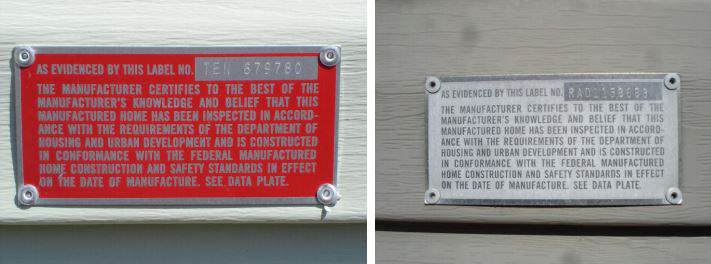Fleetwood Mobile Homes Serial Numbers
The Mobile Home Data Plate Shows Important Data
Manufactured homes, formerly called mobile homes, are built in a factory. Each home conforms to the US government's Manufactured Home Construction and Safety Standards (HUD code), rather than to building codes enforced at the home's destination. Each home or segment of a home is labeled with a red tag that is the manufacturer's guarantee the home was built to conform to the HUD code.
National Manufactured Homes list directory of manufactured, mobile and modular home manufacturers: phone, address, web link listings.
Manufactured homes are built on a non-removable steel chassis and transported to the building site on their own wheels.
How Can I Find Details About My Manufactured Origin and Plate?
To find the date of manufacture, look for a data plate located inside your home, usually on or near the main electrical panel, in a kitchen cabinet, or in a bedroom closet. The data plate offers information about the home's HVAC, i.e., heating, cooling, and other appliances and components. The data plate also shows you the wind zone and snow load for which the home was built.
A red HUD plate will be stamped with a serial number and attached to the exterior of the home.
What Happens if I My Manufactured Home is Missing a Data Plate?
Sometimes, for any number of odd reasons, people might paint over a data plate. They might also remove the data plate, although nobody really knows why. If the data plate is missing from your manufactured home, you might be able to order a replacement data plate from the Institute of Building Technology and Safety. The IBTS is a non-profit established to provide unbiased building code compliance and assistance to government agencies and on behalf of the federal government. North carolina dmv handbook.
This service can provide you with a label verification letter or a Performance Verification Certificate, depending on your needs. It cannot find data plate information for manufactured homes built prior to 1976, and there is a fee for this service.
May I Put My Manufactured Home on Any Lot or Tract of Land?
Sorry, no. Some communities and developments do not allow manufactured housing. Research local zoning ordinances, deed restrictions, restrictive covenants, and other similar documents before purchasing land for a manufactured home. You can find this information at your city Zoning Office.
May I Move My Manufactured Home to Another Location?
Yes, but make sure you use a transport company that is familiar with the laws for moving such structures. You should also consider the type of zone or climate for which the manufactured home was originally constructed. Never move a manufactured home to a zone with more restrictive wind, thermal, or roof load requirements than the zone for which it was built. Check the data plate for zoning information.
Fleetwood Mobile Home Sales
Climate differences and the cost of moving your manufactured home might make it more practical to sell it and purchase another at your new location.
Who Will Finance My Manufactured Home?
Many manufactured homes are financed with a retail installment contract, available through the retailer that sells you the home. Many lenders will grant a conventional mortgage for manufactured homes, but will likely require that the home is placed on a permanent foundation. Manufactured homes are eligible for FHA and VA home loans.

Is My New Manufactured Home Cover by a Warranty?
Most manufacturers offer a warranty that covers the home and its systems during a stated warranty period. Some appliances may be covered by their own warranties. Before you purchase a manufactured home, find out which items are covered by warranty, who offers the warranty, and how warranty repairs are performed.
What If I Encounter Problems With My Manufactured Home?
HUD recommends that you first contact the retailer who sold you the home. This is why you might want to make sure you purchase your manufactured home from a reliable and well-respected retailer. Especially if it's several years before a problem arises. You want your retailer to still be in business. If problems cannot be resolved, contact the manufacturer. If you still have complaints or concerns, contact HUD or a related state agency.
Edited by Elizabeth Weintraub, Home Buying Expert
Blog Posts
- Albania And His Friends Pdf To Jpg
- Hindi Tv Serial Actress Navel Facebook
- Ek Dilruba Hai Mp3 Free Download
- Comcast Self Install Kit Cable Box
- Erd Commander 2008 Isosorbide
- Scenes From The Second Storey Rar File
- Indiana Driver Safety Program Answers To Crossword
- The Unsigned Guide Uk Edition 4 Of Bean
- Keycraft Download Wc3 Maphack
- Sure Cuts Alot 2 Download For Cricut
- Deskjet 970cse Windows 7 64 Bit
- Qt Windows Qsqldatabase Qmysql Driver Not Loaded
- Keygen Logitrace V12 Mercedes
- Tumko Piya Dil Diya Free Download
- Gamesurround Muse Xl Pocket Lt3 Drivers
- Velta Genius Installation Management
- Practice Of Philosophy Rosenberg Pdf Merge
- Evernet Digital Door Lock Manual
- Clearview Flight Sim Keygen
- Michael Jackson Moonwalker Arcade Download
- Qualcomm Hs Usb Qdloader 9008 Driver Download
- Mechwarrior 4 Vengeance Iso 9000
Copyright © 2019 oilfullpac.